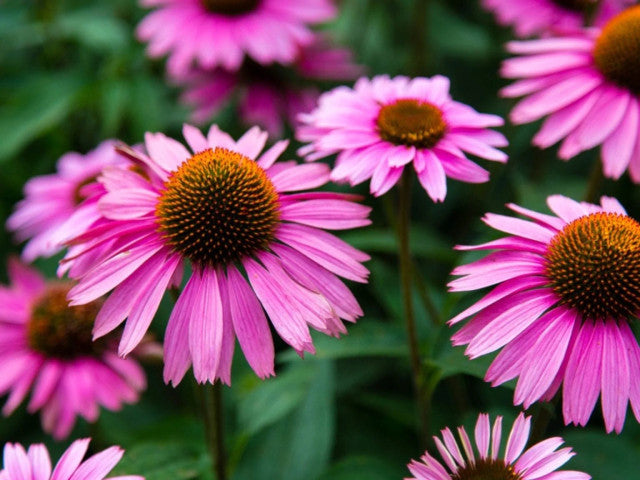
Echinacea
Sun-Loving Echinacea, a Hardy Perennial, Makes a Stellar Garden Plant
Echinacea, or coneflower, is a sun-loving perennial plant prized in many gardens for its attractive flowers, resilience, and benefits to wildlife. Native to North America, it’s most easily identified by its daisy-like flowers with drooping petals around a prominent, cone-shaped center. Petals can be purple, pink, white, orange, or yellow, depending on the species and variety, but the familiar purple coneflower (Echinacea purpurea) is the most common and widely cultivated.
What time of year do Echinacea bloom?
Blooming from midsummer to fall, echinacea provides bright color during the hottest time of year, when many other flowers start to fade. Tall, sturdy stems, usually 2 to 4 feet tall, hold blooms above the foliage, making them striking focal points in flower beds, borders, and pollinator gardens. The blooms make long-lasting cut flowers and can also be dried for bouquets.
One of echinacea’s key strengths as a garden plant is its toughness. It thrives well in full sun and well-drained soil, and tolerates heat, drought, and poor soil. Maintenance needs are minimal once it’s established, making it a “set it and forget it” plant for busy gardeners. A deep taproot enables it to survive long dry spells without watering, and strong stems usually mean it won’t need staking. Deer tend to leave it alone, so it’s a good option for gardens where deer are a problem.
Ecologically, echinacea is a superstar. Bees, butterflies, and other pollinators are drawn to its nectar-rich flowers throughout the summer. Goldfinches and other seed-eating birds enjoy its seed heads through fall and winter, so many gardeners leave the dried flower stalks standing after blooming is finished to provide food and winter interest.
Does Echinacea grow well with companion plants?
In the garden, echinacea pairs well with other sun-loving perennials like black-eyed Susans, bee balm, ornamental grasses, and butterfly weed. Planting in groups rather than singly creates a stronger visual impact and helps pollinators find the flowers.
Gardeners choose echinacea because it’s an attractive and versatile plant that offers color, value to wildlife, and tough-growing habits all in one package. It can fit in anywhere, from cottage gardens to prairie-style plantings to formal beds, and “plant it and forget it” characteristics make it a favorite for gardeners who are too busy to fuss. With a long bloom time, ability to thrive on neglect, and valuable role supporting pollinators, echinacea isn’t just a pretty face—it’s a mainstay of a healthy, vibrant garden.




